
Andy Lloyd's Dark Star Blog

Blog 19 (October 2014)
The Departure of Sin
Here's some correspondence from a researcher named Nibbie which highlighted some material I hadn't come across before:
Andy, I was on your
page. Last
time Nibiru was here is told by the queen of Harran
Nannas girl friend. I the lady Adda-guppi’, mother. of Nabium-na’id,
king of Babylon, votaress of the gods Sin, Nin-gal,
Nusku, and Sadarnunna, my deities. who, from my
childhood, have sought after. their godheads.
Whereas in the 6th year of Nabopolassar, king of
Babylon, Sin, king of the gods, with his city. and
his temple was angry and went up to heaven-the city
and the people that were in it went to ruin."
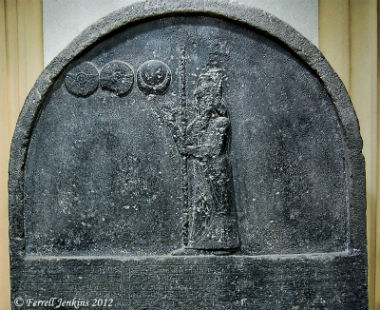
The Nabonidus Stele from Harran (7)
This happened about 500bce so do the math, 1000+ years to Nibiru." The inscription Nibbie mentions is from an ancient Babylonian Stele which was discovered in an a mediaeval mosque in what was Harran by the archaeologist Dr D. S. Rice, as part of a set of four which had been helpfully put to work in latter times as a series of steps (2). The inscription appears to suggest that the Mesopotamian god Sin, for whom a temple was built in the city, 'went up to heaven' in something of a mood. Does this provide an ancient account of the flight of the gods from Earth?
If so, then the account is very helpfully dateable. Nabopolossar was King of Babylon from 625 - 605 BCE (3), so his 6th year in that role occurred in 619 BCE, which was 2632 years ago. As Nibbie points out, if Sin's departure at that date was coincident with a perihelion passage of the planet Nibiru - as described by Zecharia Sitchin in his Earth Chronicles series (4) - then the next return date for Nibiru is in about 1000 years time (assuming that Sitchin's assumption that the orbital period = 3600 years is correct).
The temple to Sin in Harran was restored decades later by the Babylonian King Nabonidus, who was something of a fan of the Moon god. My correspondent Nibbie takes his argument further On October 10, 539 BC, Nabonidus surrendered and fled from Cyrus [the Great]. Two days later the Persian armies overthrew the city of Babylon. Nabonidus was the son of Adda_Guppi and it was she that talked Nannar to put her son in charge of Babylon. Cyrus drove him out and reinstalled Marduk as god of Babylon. Its hard to pinpoint when it [Nibiru] was here last but this should be close." (1)
So, how does this compare with Sitchin's timings for Nibiru? Contrary to popular belief, Sitchin did not advocate the widely held notion that Nibiru appeared about 1600 BCE (thought to be the approximate dating for the Biblical accounts of the Exodus), which would then follow that its presence is currently due a return. Instead, he wrote about a state visit by the god Anu to earth "circa 4000 BCE" (5), and the juxtaposition of this event with the starting of the Calendar of Nippur in 3760 BC, which "is still followed as the Jewish calendar to this day" (5).
These may have been coincident with a return of Nibiru, although Sitchin hedged even here, suggesting that "comings and goings between Earth and Nibiru were more frequent than once in 3,600 years" (5). Nevertheless, the advent of the red star/planet in the heavens would certainly have been a good excuse to kick-start a new calendar, so 3760 BCE might make much sense.
That might suggest a return date for Nibiru somewhere between 400 BCE and 160 BCE. But in his 2007 book "The End of Days", Sitchin argued that Nibiru came early, setting off a wave of Messianic prophecy and political intrigue prior to the predicted time. He argued that the sacking of Jerusalem in 560 BCE marked the departure point for the remaining Anunnaki on Earth, an event linked to Nibiru's return (6). One can see, then, how my correspondent Nibbie's argument ties in with that of the late Zecharia Sitchin, and how Nannar/Sin's departure, as recorded by the King Mother Adda-Guppi, seems to fit reasonably well with these dates.
For me personally, I remain open-minded on this issue as I'm not even really sure that the 3,600 year period is a workable solution to Nibiru's extraordinary orbit, as it provides us with a maximum aphelion distance that may be too close for modern astronomers to have missed finding the planet - particularly if Nibiru is a Dark Star object. Even so, I'm obliged to Nibbie for pointing out this interesting piece of textual evidence.
Written by Andy Lloyd, 9th October 2014
References:
1) Correspondence from Nibbie, 7 October 2014, who recommends the contents of the Emerald Tablets:
2) "Harran" Stele H1.B Column 1, verses 1-9
bibliotecapleyades.net article
3) "Nabopolassar"
4) Zecharia Sitchin "The Twelfth Planet" Avon, 1976
5) Zecharia Sitchin "There Were Giants Upon the Earth: Gods, Demigods, and Human Ancestry: The Evidence of Alien DNA", Bear & Company, 2010, pp 209-10,
![]() There Were Giants Upon the Earth
There Were Giants Upon the Earth
6) Zecharia Sitchin "The End of Days: Armageddon and Prophecies of the Return" William Morrow, 2007
7) Image reproduced with kind permission of Ferrell Jenkins
ferrelljenkins.wordpress.com article
The Mysterious Origin of Lunar Water
Recent findings suggest that water found on or just below the surface of lunar rocks might indeed have originated from the solar wind (1,2). Until recently, the Moon was thought to be devoid of water, very much in keeping with its image as a featureless, grey desert. But in 2009, a fresh look at our neighbouring satellite using instrumentation on India's Chandrayaan-1 probe showed that many of the minerals on the lunar surface are infused with water (3).
It begged the question at the time why the previous super-powers had not included instrumentation capable of detecting water on the lunar surface during their extensive explorations in the past - but it turned out they had, inadvertently anyway. Some NASA probes passed the Moon en route to their destinations and tested out their equipment on the lunar surface. I guess no one bothered to actually check for lunar water at the time; assuming none would be there. But in the light of India's shock findings in 2009, NASA re-examined that stored data and confirmed the presence of water ice on the lunar surface.
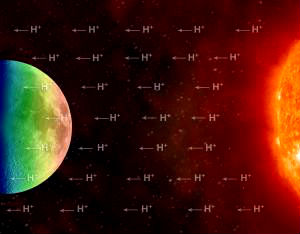
Photo Credit: University of Maryland/F. Merlin/McREL
The shock finding was therefore quickly accepted by the scientific community, and created a debate about where that water came from. The front-runner was water ice deposited onto the lunar surface by comet impacts over the lifetime of the Moon itself. That may well turn out to be true for the more substantial bodies of water ice trapped in the bottom of dark lunar craters (4), particularly during the late, heavy bombardment event which spanned a particularly violent period of time in the early solar system, beginning about 3.9 billion years ago (5) and lasting perhaps as long as 1 billion years (6).
But the surface water discovered in 2009 seems to have a more dynamic characteristic, coming and going gently with the lunar day, and perhaps implying that some kind of chemical process was at work instead (3). In other words, the solar wind carries charged protons which interact with oxygen rich molecules on the lunar surface, creating water. That water then 'moves' about through sublimation - and perhaps even straightforward water flow - as the lunar day/night cycle heats and cools the surface.

However, there are other possibilities that the expert advocates of this new idea (about the solar wind being the main source for water on and just below the lunar surface) haven't considered. As regular readers of this blog will recognise, the initial position of the Earth in the solar system need not be set in stone. Indeed, there are good reasons to believe that the Earth began life as a watery world positioned where the asteroid belt is now (7). The early solar system contained an abundance of water, which is now thought to have largely originated in interstellar space before the formation of the Sun and its accompanying proto-planetary disk (8). Indeed, if the Sun's formation is typical, then it seems as though abundant levels of potentially organic-rich interstellar water is available to all nascent star systems (9).
""Our findings show that a significant fraction of our solar system's water, the most fundamental ingredient to fostering life, is older than the sun, which indicates that abundant, organic-rich interstellar ices should probably be found in all young planetary systems," said Conel Alexander" [one of the scientists involved in this latest finding] (8)
So, all of the planets in the early solar system had plenty of water to start with, that much is sure, and much of it was around long before the Sun was. If the Moon and Earth began life in the asteroid belt zone, as I have argued, then they would have kept much of that water for an extended time period, compared with, say, Venus and Mercury whose water would have been stripped off by the solar wind more readily.
If comets tell us anything at all, it's that volatiles are driven off by increasing proximity to the Sun, including water. The fact that Earth seemingly escaped this fate may have much to do with a planetary migration pattern that propelled it closer to the Sun, after its oceans and protective atmosphere had become established.
I'd argue that the lunar water is largely a remnant from a previously more watery (well, icy) period (pre-catastrophe). So, while the comet-delivery theory and the solar wind delivery theory may contribute water to the Moon, there is a third option not considered by mainstream science because underlying assumptions about the initial location of the Earth/Moon system are wrong. That is, much of it was here all along, and for all we know is buried in significant quantities below the lunar surface, awaiting discovery.
Written by Andy Lloyd, 9th October 2014
References:
1) Paul Marks "Moon water blew in on solar wind" 7 October 2014, with thanks to Lee
2) Alice Stephant and François Robert "The negligible chondritic contribution in the lunar soils water" 3 May 2014
3) Rachel Courtland "Widespread water may cling to moon's surface" 24 September 2009
4) Hazel Muir "Comets, not asteroids, to blame for moon's scarred face" 27 July 2009
5) Uffe Graae Jørgensen et al "The Earth-Moon system during the Late Heavy Bombardment period" 23 July 2009
6) Michael Marshall "Earth's early life endured long asteroid bombardment" 15 August 2014
7) Andy Lloyd "Dark Star: The Planet X Evidence" Timeless Voyager Press, 2005, pp 80-1,
8) Catherine Griffin "The Water in Our Solar System and on Earth is Older Than the Sun" 26 September 2014
scienceworldreport.com article
9) L. Ilsedore Cleeves et al. "The ancient heritage of water ice in the solar system" Science, 345 (6204): 1590-1593, 26 Sept 2014
Red Winged Disk in the Staffordshire Hoard
My colleague Lee Covino chanced upon this Red Winged Disk symbol as he read an online article from 'The Independent' (1) about the remarkable 7th-9th Century Saxon Staffordshire Hoard (2). The symbol adorns a particularly elaborate sword hilt, one of many similar items in the treasure. It's not particularly clear where this symbol itself might have originated from, as this ancient Mesopotamian/Egyptian seems curiously out of place in Anglo-Saxon Britain during the Dark Ages. But here it is nonetheless. Perhaps it's a result of some secret symbolism, either pagan or perhaps Gnostic Christian.

It's generally appreciated these days that the Vikings, in particular, enjoyed trade and contact with far-flung peoples around the globe, as exotic foreign items discovered in their hoards have shown. Perhaps the Saxons were the same, although surely not to the same degree as their intrepid Nordic cousins? Even so, they might have incorporated much into their own Teutonic mythology from here, there and everywhere down the ages, the history of which is now obscured by the abundant sources of zealous censorship dominant at that time (they don't call them the Dark Ages for nothing, after all). Or perhaps the symbol truly does allude to a celestial event.
Some have speculated, based on evidence from tree-rings and historic data of meteoritic impacts, that the Dark Ages were ushered in by some kind of celestial catastrophe, like the explosion of a comet near to the Earth (3). If this was so, then this remarkable event likely occurred back in the 6th century, a little time before the estimated time for the forging of this fabulous Saxon sword hilt.
Written by Andy Lloyd, 9th October 2014
References:
1) David Keys "Britain's greatest treasure hoard reveals how goldsmiths fooled the Anglo-Saxon world" 17 October 2014, thanks to Lee
independent.co.uk news2) Staffordshire Hoard
3) Roger Highfield, Robert Uhlig and David Derbyshire "Comet caused Dark Ages, says tree ring expert" 9 September 2000
New Planets Await Discovery in the Inner Oort Cloud
It is becoming increasingly apparent over time that the outer solar system likely contains one or more significant, undiscovered planets. It's one of those odd situations where astronomers find themselves in agreement with advocates of the Planet X phenomenon, although they likely wouldn't admit it.
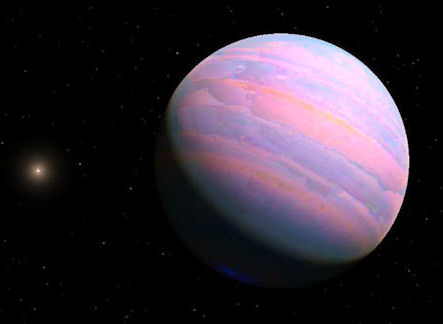
A lot of this speculation in the scientific community has to do with the shape and populations of bands of objects in the outer solar system. Beyond Neptune, a second asteroid belt exists between 30AU and 50AU known as the Kuiper Belt. It cuts off quite dramatically at the 50AU mark, the reason for which is still debated. The next zones involve the comets, distributed into two clouds of objects. The outer of these zones is the hypothesized Outer Oort Cloud, a truly immense shell of comets some of which fall towards the Sun occasionally; the observations of which themselves imply this cometary source in the first place. Comets in the Outer Oort Cloud are sufficiently removed from the Sun to be gravitationally affected by exterior sources, thereby altering their distribution beyond the primordial setting-in-motion at the solar system's birth.
Between the now well-established Kuiper Belt and the still hypothesized outer Oort Cloud (after all, why couldn't the incoming long-period comets initially be interstellar in nature?) there is a third zone known as the Inner Oort Cloud, a zone which is only now beginning to relinquish its secrets.
The number of the known objects in this zone (between 50AU and 1500AU) is small. Very small, in fact - at the time of writing it consists of only 2 objects. But, as few as they may be, the discovery and orbital properties of these two objects bring with them profound implications, and may point to the existence of a dark, undiscovered planet beyond. I reported on the discovery of one of these objects, and its ramifications, back in my April Dark Star Blog (1). Since then researcher Barry Warmkessel has unearthed a follow-up scientific article written by the discoverers of 2012 VP113 themselves, including these intriguing quotes:
"From the amount of sky area searched, [astronomers] Trujillo and Sheppard determine that about 900 objects with orbits like Sedna and 2012 VP113 are out there with sizes larger than 1000 km and that the total population of the inner Oort cloud is likely bigger than the Kuiper Belt and main asteroid belt. "Some of these inner Oort cloud objects could rival the size of Mars or Earth. This is because most of the inner Oort cloud objects are so distant that even very large ones would be too faint to detect with current technology", says Sheppard.
"Both Sedna and 2012 VP113 were found near their closest approach to the Sun, but they both have orbits that go out to hundreds of AU at which point they would be too faint to discover. In fact, the similarity in the orbits found for Sedna, 2012 VP113 and a few other objects near the edge of the Kuiper Belt suggests that an unknown massive perturbing body may be shepherding these objects into these similar orbital configurations. Sheppard and Trujillo suggest a Super Earth or an even larger object at hundreds of AU could create the shepherding effect seen in the orbits of these objects, which are too distant to be perturbed significantly by any of the known planets." (2)
There are other possible explanation as well, as the writers suggest. A rogue planet might have created these effects early, setting the objects in motion and then disappearing into interstellar space. Alternatively, the passing star might have caused some temporary rearrangement of some Kuiper Belt objects, shuffling objects like Sedna and so-called Biden (named after the VP in 2012 VP113) into the "Inner Oort Cloud" zone.
But then one still has to explain the Kuiper Cliff at 50AU, and seemingly the best way to do that is to appreciate the shepherding influence of an unseen body. It's interesting that the guys who are actually doing the science on the composition of the outer solar system are open to - even supportive of - the seemingly radical notion that a large planet remains undiscovered out there; a Planet X by any other name.
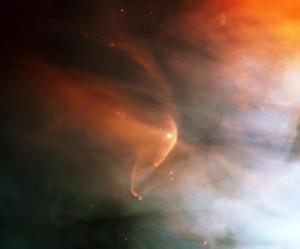
Barry has provided a comparison between the orbital parameters of 'Biden' with his own group's hypothesized sub-brown dwarf planet Vulcan (3), which place Vulcan into this Inner Oort Cloud zone. Perhaps, then, such a relatively nearby massive planet might be directing the traffic of these rare but vitally important objects (Sedna and Biden), and shaping the Kuiper Cliff by sweeping out the zone of extraneous debris.
A more recent scientific paper, that was published in June 2014 (4), speculated that the patterns seen in these Inner Oort Cloud objects provide a possible basis for two massive planets in that swept-out zone. The Spanish astronomers who wrote the paper have matched the subtle orbital patterns observed to modelled orbital resonance patterns with hypothesized massive planets located between 200 - 250 Astronomical Units (5). These hypothesized planets are projected to have circular orbits.
Now, this match could be spot on, or there might be a myriad of other possibilities that also provide a fit between what is observed with these Inner Oort Cloud objects and models of such objects being shepherded by massive planets beyond. For instance, the combined effect of a terrestrial Planet X body within the Inner Oort Cloud (Nibiru) and a much more substantial sub-brown dwarf object way out in the Oort Cloud (the Dark Star), either one of which might exhibit eccentric orbital patterns. This scenario would explain a lot more than just the eccentric behaviour of Sedna and Biden.
Written by Andy Lloyd, 20th October 2014
Reference:
1) Andy Lloyd "New Object in Outer Solar System Hints at Planet X" 27 March 2014
andylloyd.org/darkstarblog13.htm
2) Scott Sheppard & Chad Trujillo "Beyond the Edge of the Solar System: The Inner Oort Cloud Population" with thanks to Barry
ciw.edu article3) Barry Warmkessel "Vulcan's and Biden's Orbital Parameters"
4) C. de la Fuente Marcos, R. de la Fuente Marcos "Extreme trans-Neptunian objects and the Kozai mechanism: signalling the presence of trans-Plutonian planets" Monthly Notices of the Royal Astronomical Society: Letters, 443(1): L59–L63, 1 September 2014
academic.oup.com/mnrasl article
5) Nicola Jenner "Two giant planets may cruise unseen beyond Pluto" 11 June 2014
The Mystery of South Africa's Ancient Structures
Some more information and images relating to the remarkable, ancient structures dotted across the southern countries of Africa, as popularised recently by South African researcher Michael Tellinger (1). The Google Earth image (above right) has been discussed on Facebook by Derrick Scott van Heerden who notes the incredible extent of these large, ancient settlements in the Mpumalanga province of eastern South Africa (2). My colleague Lee Covino points out what appears to be terracing interspersed across the landscape around these corral-like stone structures
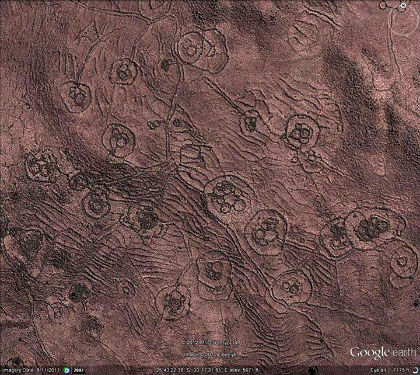
Photo credit: Derrick Scott van Heerden (1)
Take a look at the aerial view of the famous site of Great Zimbabwe, a remarkable Zimbabwean 11th Century site (3,4) whose enclosure features 5 metre high dry stone walls (below right). The plan of this 1000 year old structure seems to share similarities with these extensive corrals suggesting, perhaps, a deep-seated tradition of construction of sites of this nature going way back into antiquity. Given that Great Zimbabwe is undeniably a walled settlement, the implication is that the other, more ancient corrals were also used as settlements. Which then leads us to ponder upon the sheer numbers of these settlements strewn across the landscape of southern Africa. The implication is that this landscape was essentially once city sprawl, akin to a vast, Palaeolithic Los Angeles!
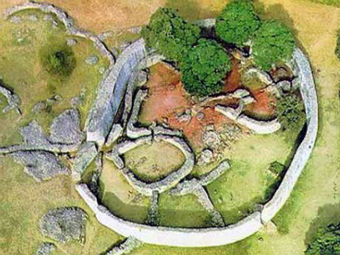
An aerial view of Great Zimbabwe
Theories abound about why this area was once so heavily developed in ancient times, but most of the ideas revolve around the abundance of mineable gold to be found in the area. Researcher John Bradfield discusses the colonisation of the area by Indian miners, facilitated by the extensive travels of Dravidian seafarers with a 'lust for Afican gold' (5). He highlights the work of South African historian Cyril Hromnik who dared to set the clock back for this ancient gold rush to a time some 40,000 years ago:
"The story goes back even further than this. As a leading proponent of the popular “alternative history” theory, Dr Hromnik contends that Mpumalanga was settled by ancient sea-faring Hindus some 40,000 years ago. They came for the ivory, the gold and the iron and erected temples and astronomical observatories on mountain tops. They built strong stonewalled cities from which they hunted, mined and traded throughout Southern Africa.
"Dr. Hromnik believes that these people, who were mainly speakers of Dravidian languages and early Shivites by religion, were responsible for the ancient gold mines found in South Africa, Mozambique and Zimbabwe." (5)
However, as we have considered in recent Dark Star Blogs already (6,7,8), these ancient corral-like structures, which appear to be inhabitations or settlements, show striking similarities with ancient structures in Syria. Far from being a connection with the Indian sub-continent, then, the ancient gold rush settlements of southern Africa appear to be linked more closely with the Levant. This connection bears a striking similarity with the speculative theories expressed by Zecharia Sitchin regarding extensive gold mining by the slaves of the Anunnaki in the area (9). Does the work of Dr Hromnik provide us with an archaeological and pre-historical timeline for this ancient gold-mining extravaganza?
Written by Andy Lloyd,
25th October 2014
References:
1) Andy Lloyd "Book Review of 'Temples of the African Gods' by Michael Tellinger and Johan Heine" 22 January 2012
2) Photo credit: Derrick Scott van Heerden/Google Earth
3) Great Zimbabwe
4) Great Zimbabwe with Great Enclosure
5) John Bradfield "Gold in South Africa and the Ancient Indian Connection" 23 October 2011
6) Andy Lloyd "Syrian Stone Circles Connection" November 2013,
andylloyd.org/darkstarblog08.htm
7) Andy Lloyd "Syrian Circles Update" May 2014
andylloyd.org/darkstarblog14.htm
8) Andy Lloyd "Stone Circles on Golan Heights were Bronze Age Habitations" September 2014
andylloyd.org/darkstarblog18.htm
9) Zecharia Sitchin "The Twelfth Planet" Avon, 1976

You can keep informed of updates by following me on Twitter:
![]()
Or like my Facebook Page: https://www.facebook.com/darkstarandylloyd